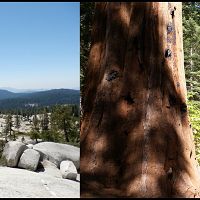Claire Lukens

PhD. Student; Department of Geology and Geophysics
University of Wyoming - University of Wyoming
M.S., Geology, University of Wyoming, 2010
I am interested in how mountains evolve over time. Tectonics, sedimentation, climate, and the interactions between them all play into the evolution of mountain ranges, so I get to dabble in several disciplines. My PhD work with Cliff Riebe is focused on the geomorphic end of this spectrum, delving into watershed-scale erosion, sediment transport, and sediment source on a landscape. The basic tenet is this: If you were to stand on a stream bank and look at all the sediment in the stream, where did that sediment come from? How did it get there? What can the stream sediment tell us about the geomorphic processes shaping the landscape? To this end, I am employing a combination of apatite (U-Th)/He dating, cosmogenic nuclides, and numerical modeling to address how sediment source and erosion vary across watersheds. Currently, this work is focused at field sites in the Sierra Nevada, with several additional sites in the wings pending preliminary results.
-
CZO Publications
Papers/Books
2017
The problem of predicting the particle size distribution of sediment supplied by hillslopes to rivers. Sklar, L. S., Riebe, C. S., Marshall, J. A., Genetti, J., Leclere, S., Lukens, C. L., Merces, V. (2017): Geomorphology. 277 31.
2016
Grain size bias in cosmogenic nuclide studies of stream sediment in steep terrain . Lukens, C. E., Riebe, C. S., Sklar, L. S., Shuster D. L. (2016): Journal of Geophysical Research: Earth Surface. 121 (5), DOI: 10.1002/2016JF003859
2015
Climate and topography control the size and flux of sediment produced on steep mountain slopes. Riebe, C., Sklar, L., Lukens, C., and Shuster, D. (2015): Proceedings of the National Academy of Sciences
2014
Bedrock composition regulates mountain ecosystems and landscape evolution. Hahm, W.J., Riebe, C.S., Lukens, C.E., and Araki, S. (2014): Proceedings of the National Academy of Sciences 111(9):3338-3343
Papers and books that explicitly acknowledge a CZO grant are highlighted in PALE ORANGE.
Other CZO Publications
2016
Spatial variations in the size distribution of sediment supplied to channels: A synthesis of detrital thermochronometry from 11 size classes in Inyo Creek, California. Lukens, C.; Shuster, D.L.; Sklar, L.S.; Riebe, C.S. (2016): Fall Meeting, American Geophysical Union, December 2016. Abstract EP34A-02.
2015
If Rocks Could Talk: Origin Stories of Stream Sediment Told by Apatite Helium Ages and Cosmogenic Nuclides. Lukens, C., Riebe, C., Sklar, L., Shuster, D (2015): American Geophysical Union Fall Meeting. San Francisco, CA
2015
If Rocks Could Talk: Origin Stories of Stream Sediment Told by Apatite Helium Ages and Cosmogenic Nuclides. Lukens, C., Riebe, C., Sklar, L., Shuster, D. (2015): EP41C. Mechanistic Underpinnings of Damage, Distruption, and Transport of Rock and Regolith Posters, presented at 2015 Fall Meeting, AGU, San Francisco, CA, 14-18 Dec.
2015
Climate and topography control the size and flux of sediment produced on steep mountain slopes. Riebe, C., Sklar, L., Lukens, C., and Shuster, D. (2015): Proceedings of the National Academy of Sciences
2013
Strong Lithologic Control on Mountain Ecosystem Productivity and Landscape Evolution. Hahm, W.J., C.S. Riebe, C.E. Lukens, and S. Araki. (2013): The Geological Society of America annual meeting
2013
Evidence for climatic and topographic control of the size and flux of eroded sediment across a steep mountain catchment. Lukens, C., C.S. Riebe, L.S. Sklar, and D.L. Shuster. (2013): American Geophysical Union, Fall Meeting 2013, abstract EP52A-05.
2013
Bedrock composition limits mountain ecosystem productivity and landscape evolution. Riebe, C.S. W.J. Hahm; and C. Lukens (2013): American Geophysical Union, Fall Meeting 2013, abstract #B13L-02
2012
Moving beyond the average in cosmogenic nuclide studies of erosion and weathering. Lukens, C., Riebe, C.S., Sklar, L.S., and Shuster, D.L. (2012): Fall Meeting, American Geophysical Union, December 2012. Abstract EP41D-0822.
-
News

SSCZO’s Cliff Riebe and Claire Lukens shed light on the role of sediment size in landscape evolution
26 Jan 2016 - Riebe et al. combine old isotopic techniques in new ways, with big results showing connections between sediment size, erosion, topography, and climate

UW Study: Bedrock Influences Forests More Than Previously Believed
10 Feb 2014 - Bedrock influences forests and landscape evolution much more than was previously thought, according to a study by University of Wyoming scientists.
-
Events
Controls on Size and Flux of Sediment; Riebe
Climate and Topography Control the Size and Flux of Sediment Produced on Steep Mountain Slopes
CCC Mile High Ballroom 2C.
Explore Further

